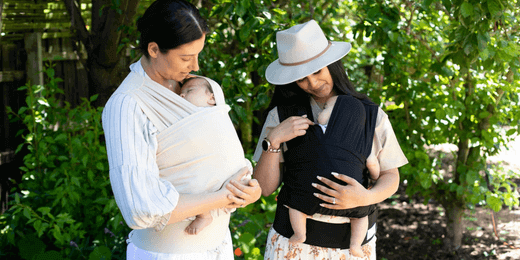Welcome to the exciting journey of parenthood!
As we hit the 6-month mark, your baby starts charming you with adorable sounds – like "ma" and "da da," and the occasional defiant "no." Your little one is officially finding their voice, and that's just the beginning!
Join us as we explore the enchanting world of your baby's development, celebrating each precious moment of your little one.

Newborn Milestones
In these initial stages, your baby is already a vibrant participant in their surroundings, expressing sheer joy through infectious smiles, bouts of laughter, and the beginning of delightful babbling conversations.

Baby's Growth: The Newborn Stage

The first month of your baby's life is a period of immense adjustment and discovery for both parents and the newborn.
Understanding the characteristics of this stage can help create a supportive environment for your baby's optimal development.
Sleeping Patterns: Newborns sleep 16-18 hours a day, but it's fragmented. Create a calming bedtime routine for healthy sleep.
Feeding Routines: Feeding every 2-3 hours is crucial. Make feeding a bonding time in a comfortable space.
Early Bonding: Build a strong bond through skin-to-skin contact, cuddling, and talking.
Why Choose BabyDink for Skin-to-Skin Contact?
BabyDink takes inspiration from the concept of kangaroo care, promoting uninterrupted skin-to-skin contact between you and your baby. This practice is not only known to provide numerous physical and emotional benefits for your little one but also serves as a powerful tool for strengthening the parent-child bond.
Kangaroo care is a gentle yet powerful practice that goes beyond physical closeness, nurturing the emotional, cognitive, and physiological well-being of your baby. As you snuggle your little one in the warmth of kangaroo care, you're not just providing comfort – you're laying the groundwork for a lifetime of health and happiness.
Awakening Senses (2nd-3rd Month)

The second and third months mark a fascinating phase in your baby's growth as their senses start to awaken. Understanding and actively engaging in activities that stimulate their senses are vital for their overall growth.
Vision: Your baby's vision is still developing, and during this period, they can focus more on objects and follow them with their eyes. Use high-contrast toys and patterns to capture their attention. Spending short periods in well-lit rooms helps enhance their visual experiences.
Hearing: Around the second month, your baby becomes more attuned to sounds. They may turn their head towards voices and show interest in music. Incorporate gentle lullabies or soothing sounds into your routine. Speaking softly to your baby helps in the development of auditory recognition.
Touch: The sense of touch is crucial for your baby's emotional well-being. Provide tactile stimulation through gentle massages, soft fabrics, and skin-to-skin contact.
Practical Activities and Tips
Stimulating Vision
-
Contrasting Colors: Introduce toys and objects with bold, contrasting colors to attract your baby's attention.
-
Visual Tracking: Move a toy slowly within their line of sight, encouraging them to follow the movement with their eyes.
Enhancing Hearing
-
Soft Music: Play soft music or gentle lullabies during quiet moments to create a calming atmosphere.
-
Narrate Activities: Describe your daily activities to your baby, allowing them to familiarize themselves with the cadence of your voice.
Road to Mobility (4th-6th Month)

The period between the fourth and sixth months is an exhilarating time as your baby embarks on the road to mobility. Witnessing the development of motor skills is not only thrilling but also crucial for their overall growth.
During these months, you'll observe a shift from basic, reflexive movements to more intentional actions. Your baby starts to explore their surroundings by reaching out and grasping objects. Provide a variety of safe and age-appropriate toys to encourage this exploration.
Crawling Milestone:
Around the fifth month, many babies begin to show signs of crawling. This milestone is a significant leap in their physical development. Encourage crawling by placing enticing toys just out of reach, providing motivation for them to explore the world around them.
Sitting Milestone
Sitting independently is another major achievement during this period. Support your baby's developing core strength by placing them in a sitting position with cushions for stability. This newfound ability opens up a whole new perspective for your baby, allowing them to interact with their environment from a different vantage point.
Significance in Physical and Cognitive Growth
The ability to crawl and sit independently signifies more than just physical milestones. These achievements contribute significantly to cognitive growth and overall development.
-
Enhanced Exploration: Crawling allows your baby to explore their environment actively, fostering curiosity and a sense of independence.
-
Fine Motor Skills: Reaching and grasping contribute to refining fine motor skills. This sets the stage for later activities like self-feeding and manipulating objects.
-
Spatial Awareness: Sitting independently enhances your baby's spatial awareness, laying the groundwork for activities that require balance and coordination.
Emotional and Cognitive Developmental Milestones

During your baby's first year, your baby is establishing a fundamental emotional bond with you. Infants are highly responsive to your voice, touch, and facial expressions.
As your baby approaches the sixth month, you may notice them recognize names, voices, and familiar faces. By this time, stranger anxiety may arise, indicating a growing awareness of their social environment. This is a normal part of emotional development as your baby becomes more discerning about familiar and unfamiliar faces.
Tip for Parents: Talk to your baby regularly, describing daily activities or reading simple stories. This promotes language development and cognitive engagement.
Baby's Development: Challenges and Red Flags to Look For

While each child develops independently, parents must be aware of potential challenges and developmental red flags. Recognizing these signs early on allows for timely intervention and support. Let's delve into some common challenges and red flags parents should be attentive to during this transformative period.
Feeding Challenges
Some babies may face difficulties with feeding, leading to concerns about weight gain and nutrition.
Red Flags:
-
Consistent Fussiness During Feeding: If your baby consistently appears distressed or refuses to feed, it may be a sign of an underlying issue.
-
Inadequate Weight Gain: A notable lack of weight gain or frequent weight loss could indicate feeding challenges.
What Parents Can Do:
-
Consult with your pediatrician to rule out any medical issues.
-
Consider different feeding techniques, such as paced bottle feeding or breastfeeding support.
Sleep Disturbances
Establishing a consistent sleep routine can be challenging for both babies and parents.
Red Flags:
-
Persistent Sleep Troubles: If your baby struggles to sleep for extended periods or frequently wakes up during the night.
-
Excessive Daytime Sleepiness: Constant drowsiness during the day might indicate disrupted sleep patterns.
What Parents Can Do:
-
Create a calming bedtime routine to signal to your baby that it's time to sleep.
-
Ensure a comfortable sleep environment and adhere to safe sleep guidelines.
Lack of Social Responsiveness
Some babies may show delays in social interactions and responsiveness.
Red Flags:
-
Limited Eye Contact: Infrequent or inconsistent eye contact during social interactions.
-
Minimal Facial Expressions: Limited emotional expressions or responses to stimuli.
What Parents Can Do:
-
Engage in activities that promote social interaction, such as playing peek-a-boo or making funny faces.
-
If concerns persist, seek guidance from a healthcare professional or child development specialist.
Motor Skill Delays
Not all babies reach motor skill milestones at the same time, but significant delays may warrant attention.
Red Flags:
-
Lack of Head Control: Insufficient progress in achieving head control by three to four months.
-
Limited Limb Movement: Persistent difficulty in moving arms and legs or reaching for objects.
What Parents Can Do:
-
Incorporate tummy time into your baby's routine to promote muscle strength.
-
Consult with your pediatrician if you observe significant delays in motor skill development.
Understanding the Importance of Healthy Hip Products in Preventing Hip Dysplasia
Hip dysplasia, a condition where the hip joint doesn't develop properly, is a concern that underscores the significance of choosing the right baby products, particularly those designed with healthy hip development in mind.
The International Hip Dysplasia Institute (IHDI) acknowledges swaddling and babywearing devices in order to recognise products that encourage healthy hip development. This is especially important during the first six months of life when the hips are growing rapidly.
BabyDink, prioritize the correct "M" position for your baby's hips. This ergonomic design supports the natural development of the hip joint, reducing the likelihood of hip dysplasia. Ensuring that your baby's hips are supported in this position aids in the proper alignment and growth of the hip socket.
Sudden Infant Death Syndrome: What Should You Know
Sudden Infant Death Syndrome (SIDS) is an unexplained and sudden death of an otherwise healthy infant during sleep, typically under the age of one. Understanding SIDS is crucial for prevention, risk reduction, and safe sleep education.
By identifying risk factors and implementing safe sleep practices, caregivers can reduce the risk of SIDS and create a safer sleep environment for infants. Consult healthcare professionals for personalized advice based on individual circumstances. Creating a safe sleep environment is crucial for infant well-being and SIDS prevention.
Conclusion
The first six months of a baby's life are a time of incredible transformation. By understanding the nuances of newborn development and being attuned to their developmental milestones, parents can provide the nurturing environment necessary for their child's development.
As you embrace the joyous moments of your baby grasping objects correctly and witnessing those adorable newborn movements, it's a testament to the incredible milestones unfolding before your eyes. We understand the significance of every coo, the enchanting "bye-bye" waves, and the delicate exploration of your baby's hands – each a unique expression of their evolving personality.
Your role as parents is paramount, and our shared journey is guided by insights from the National Institute, a valuable ally in your quest to understand and nurture your baby's growth.
Here's to the first six months – a journey of discovery, laughter, and an unbreakable bond. You're not alone; we're here, sharing in the joys and triumphs of this transformative time.
References:
Misirliyan, S. S., Boehning, A. P., & Shah, M. (2023). Development Milestones. In StatPearls. StatPearls Publishing. http://www.ncbi.nlm.nih.gov/books/NBK557518/
Movements, Coordination, and Your Newborn (for Parents)—Nemours KidsHealth. (n.d.). Retrieved December 10, 2023, from https://kidshealth.org/en/parents/movenewborn.html








Leave a comment (all fields required)